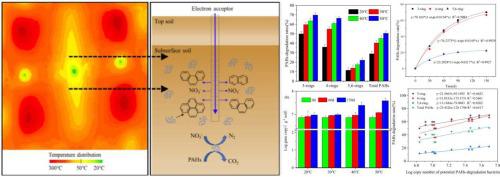Journal of Environmental Chemical Engineering ( IF 7.4 ) Pub Date : 2022-01-19 , DOI: 10.1016/j.jece.2022.107236 Zhongping Sun 1 , Li Wang 1 , Sucai Yang 1 , Yanping Xun 2 , Tengfei Zhang 1 , Wenxia Wei 1

|
During the application of in situ thermal desorption technology (ISTD), heat in some areas often can not be effectively utilized. Nevertheless, the heat in these areas might promote the biodegradation of polycyclic aromatic hydrocarbons (PAHs). However, few studies have concentrated on the effect of temperature on biodegradation of PAHs, especially under anoxic conditions. The effects of temperature on the abundance and community characteristics of indigenous bacteria in soil are also unclear. Consequently, thermally enhanced anoxic biodegradation of PAHs in subsurface soil was investigated in this study. After 150 days of anoxic incubation, both the bacterial abundance and the removal rates of PAHs in soil were positively affected by temperature. The total number of potential PAH-degrading bacteria (Proteobacteria and Firmicutes) was increased by 0.11–0.72 orders of magnitude compared to the untreated soil in different temperature treatment groups (20 °C, 30 °C, 40 °C, and 50 °C). Firmicutes was more adaptable to higher temperatures than Proteobacteria. The removal rates of total PAHs increased from 28.85% to 50.44% with increasing temperature. The degradation rates of three- and four-ring PAHs were significantly higher than those of five- and six-ring PAHs. These findings provide a more applicable and economical way to treat with PAHs contaminated subsurface soil where the temperature is lower than the target temperature needed for the desorption of PAHs from the soil when ISTD is used.
中文翻译:

高污染老化土壤中多环芳烃 (PAHs) 的热强化缺氧生物降解
在原位热脱附技术(ISTD)的应用过程中,一些地区的热量往往不能得到有效利用。然而,这些地区的热量可能会促进多环芳烃(PAHs)的生物降解。然而,很少有研究集中于温度对 PAHs 生物降解的影响,尤其是在缺氧条件下。温度对土壤中本土细菌的丰度和群落特征的影响也不清楚。因此,本研究对地下土壤中 PAHs 的热增强缺氧生物降解进行了研究。缺氧培养150天后,土壤中细菌丰度和PAHs去除率均受到温度的正向影响。与不同温度处理组(20°C、30°C、40°C 和 50°C)的未处理土壤相比,潜在的 PAH 降解细菌(变形杆菌和厚壁菌门)的总数增加了 0.11-0.72 个数量级)。厚壁菌门比变形菌门更能适应更高的温度。随着温度的升高,总 PAHs 的去除率从 28.85% 增加到 50.44%。三环和四环多环芳烃的降解率明显高于五环和六环多环芳烃。这些发现提供了一种更适用和更经济的方法来处理多环芳烃污染的地下土壤,其中温度低于使用 ISTD 时从土壤中解吸多环芳烃所需的目标温度。与不同温度处理组(20°C、30°C、40°C 和 50°C)的未处理土壤相比,提高了 72 个数量级。厚壁菌门比变形菌门更能适应更高的温度。随着温度的升高,总 PAHs 的去除率从 28.85% 增加到 50.44%。三环和四环多环芳烃的降解率明显高于五环和六环多环芳烃。这些发现提供了一种更适用和更经济的方法来处理多环芳烃污染的地下土壤,其中温度低于使用 ISTD 时从土壤中解吸多环芳烃所需的目标温度。与不同温度处理组(20°C、30°C、40°C 和 50°C)的未处理土壤相比,提高了 72 个数量级。厚壁菌门比变形菌门更能适应更高的温度。随着温度的升高,总 PAHs 的去除率从 28.85% 增加到 50.44%。三环和四环多环芳烃的降解率明显高于五环和六环多环芳烃。这些发现提供了一种更适用和更经济的方法来处理多环芳烃污染的地下土壤,其中温度低于使用 ISTD 时从土壤中解吸多环芳烃所需的目标温度。三环和四环多环芳烃的降解率明显高于五环和六环多环芳烃。这些发现提供了一种更适用和更经济的方法来处理多环芳烃污染的地下土壤,其中温度低于使用 ISTD 时从土壤中解吸多环芳烃所需的目标温度。三环和四环多环芳烃的降解率明显高于五环和六环多环芳烃。这些发现提供了一种更适用和更经济的方法来处理多环芳烃污染的地下土壤,其中温度低于使用 ISTD 时从土壤中解吸多环芳烃所需的目标温度。











































 京公网安备 11010802027423号
京公网安备 11010802027423号